Suppose a monopoly sells its product in two markets and resa
Suppose a monopoly sells its product in two markets and resale between two markets is impossible. The demand curves in the two markets are: Pi = 70 - Q1. P2 = 130 - 2Q2 The monopoly’s marginal cost is MC = $35.
a) Assume that the monopoly can practice perfect price discrimination in each market separately. What is the minimum price the firm would charge to maximize its profit? Calculate consumer surplus, producer surplus, and deadweight loss in each market.
b) Now assume that the monopolist can engage in second-degree price discrimination (instead of perfect price discrimination). More specifically, it charges $70 for the first 30 units (regardless of where it is sold), then $50 for any additional unit. Calculate consumer surplus, producer surplus, and deadweight loss in each market.
c) Now assume that this firm is engaging in third-degree price discrimination. Solve for the equilibrium price and quantity in each market.
d) Suppose that the monopolist cannot practice price discrimination (i.e, it has the charge the same price in both markets). What would be the profit-maximizing price and quantity? Would consumers be better off compared to the scenario in part (c)?
Solution
The demand curves in two markets are given as:P(1)=70-Q(1) and P(2)=130-2Q(2)
The marginal cost of the monopoly is MC=$35
We can rewrite the demand functions as:Q(1)=70-P(1) and Q(2)=65-P(2)/2
Market-1
Now,based on profit maximizing condition of the firm under 1st degree or perfect price discrimination,we obtain:-
P=MC
70-Q(1)=35
-Q(1)=-70+35
-Q(1)=-35
Q(1)=35
Now,plugging the value of Q(1) in market 1 or the profit maximizing output of the monopoly into the demand function in market 1,we get:-
P(1)=70-Q(1)
P(1)=70-35
P(1)=35
Hence, the profit maximizing price charged by the monopoly in market-1 is 35.
Now,if we assume Q(1)=0 in the demand equation,we get:-
P(1)=70-Q(1)
P(1)=70-0
P(1)=70
Now,assuming P(1)=0,we get:-
P(1)=70-Q(1)
0=70-Q(1)
-70=-Q(1)
70=Q(1)
Hence,Consumer Surplus in market 1=0.5(70-35)(35)=17.5*35=$612.5
Therefore,under perfect or 1st degree price discrimination,the minimum price that the monopoly will charge=($612.5+$35)=$647.5
Producer Surplus in market 1=0.5(70)(35)=35*35=$1225
Since,the monopoly is charging a market price equal to the profit maximizing price and the entire consumer surplus,there is no deadweight loss in market 1 implying there is no efficiency or economic welfare loss under perfect price discrimination in market-1.
Market-2
Again,based on profit maximizing condition of the firm under 1st degree or perfect price discrimination,we obtain:-
P=MC
130-2Q(2)=35
-2Q(2)=-130+35
-2Q(2)=-95
Q(2)=-95/-2
Q(2)=47.5
Now,plugging the value of Q(2) in market 2 or the profit maximizing output of the monopoly into the demand function in market 2,we get:-
P(2)=130-2Q(2)
P(2)=130-2(47.5)
P(2)=130-95
P(2)=35
Thus,the profit maximizing price charged by the monopoly in market-2 is 35.
Again,if we assume Q(2)=0 in the demand equation,we get:-
P(2)=130-2Q(2)
P(2)=130-2(0)
P(2)=130
Now,assuming P(2)=0,we get:-
P(2)=130-2Q(2)
0=130-2Q(2)
-130=-2Q(2)
-130/-2=Q(2)
65=Q(2)
Hence,Consumer Surplus in market 2=0.5(47.5)(130-35)=0.5(47.5)(95)=$2256.25
Therefore,under perfect or 1st degree price discrimination,the minimum price that the monopoly will charge in market 2=($2256.25+$35)=$2291.25
Producer Surplus in market 2=0.5(130)(47.5)=47.5*65=$3087.5
Again,observe that the monopoly is charging a market price equal to the profit maximizing price and the entire consumer surplus,there is no deadweight loss in market 2 implying there is no efficiency or economic welfare loss under perfect price discrimination in market-2.
b) Now,we consider the second degree price discrimination where the first 30 units are sold for $70 and then $50 for each additional unit.
Demand function in market 1:P(1)=70-Q(1) and demand function in Q(2):P(2)=130-2Q(2)
If we add up the demand from two markets we get a total market demand of=P(1)+P(2)=(70-Q(1))+(130-2QQ(2))
=70-Q(1)+130-2Q(2)=200-3Q where Q represents the total output combining both markets and P is the total market price.
Hence,overall market demand:P=200-3Q
The MC we know is $35
Again,based on profit maximizing condition of the monopoly,we obtain:-
P=MC
200-3Q=35
-3Q=-200+35
-3Q=-165
Q=-165/-3
Q=55 Thus,the profit maximizing output for monopoly combining both the markets is 55 in this case,
Plugging the value of Q obtained above into the demand function for both markets,we get:-
P=200-3Q
P=200-3(55)
P=200-165
P=35 This denotes the profit maximizing price charged by the monopoly in the market.
Now,assuming Q=0 in the market demand function,we obtain:-
P=200-3Q
P=200-3(0)
P=200
Assuming P=0 in market demand,we get:-
P=200-3Q
0=200-3Q
-200=-3Q
-200/-3=Q
66.66=Q
Now,notice that the monopoly charges $70 for the first 30 units flat out of the 55 units or a per unit price of $2.3 for the first 30 units.
Thus,Consumer Surplus for the first 30 units=0.5(200-2.3)(30-0)=197.7*15=$2965.5
Producer Surplus for those units=0.5(200)(30)=$3000
Also,notice that since the monopoly extracts the consumer surplus for the first 30 units separately much of the consumer surplus is also extracted by the monopoly in this case.
c) Here we examine the third degree price discrimination.
Market-1
Demand function in market 1:P(1)=70-Q(1)
Total Revenue in market 1 or TR(1)=P(1)Q(1)
={70-Q(1)}Q(1)
=70Q(1)-Q(1)^2
Now,Marginal Revenue in market 1 or MR(1):dTR/dQ(1)=70-2Q(1)
The MC=$35
Thus,based on the profit maximizing crietria of the monopoly firm under third degree price discrimination,we get:-
MR(1)=MC
70-2Q(1)=35
-2Q(1)=-70+35
-2Q(1)=-35
Q(1)=-35/-2
Q(1)=17.5
Therefore, notice that under thurd degree price discrimination the profit maxizing output for monopoly in market 1 is 17.5
Now,plugging the value of Q(1) obtained above into the demand function,we derive:-
P(1)=70-Q(1)
P(1)=70-17.5
P(1)=52.5
Thus,the profit maximizing price charge by monopolist in market 1 is 52.5 under thirds degree price discrimination.
Again,assuming Q(1)=0 in the demand function,we get:-
P=70-Q(1)
P=70-0
P=70
Now,assuming P(1)=0 in the demand function for market-1,we get:-
P(1)=70-Q(1)
0=70-Q(1)
-70=-Q(1)
70=Q(1)
Thus,the consumer surplus in market-1=0.5(70-52.5)(17.5)=17.5*8.75=$153.25
Market-2
Demand function in market 2:P(2)=130-2Q(2)
Total Revenue in market 2 or TR(2)=P(2)Q(2)
={130-2Q(2)}Q(2)
=130Q(2)-2Q(2)^2
Now,Marginal Revenue in market 2 or MR(2):dTR(2)/dQ(2)=130-4Q(2)
The MC=$35
Thus,based on the profit maximizing crietria of the monopoly firm under third degree price discrimination,we get:-
MR(2)=MC
130-4Q(2)=35
-4Q(2)=-130+35
-4Q(2)=-95
Q(2)=-95/-2
Q(2)=47.5
Therefore, notice that under third degree price discrimination the profit maxizing output for monopoly in market 2 is 47.5
Now,plugging the value of Q(2) obtained above into the demand function,we derive:-
P(2)=130-2Q(2)
P(1)=130-2(47.5)
P(2)=130-95
P(2)=35
Thus,the profit maximizing price charge by monopolist in market 2 is 35 under thirds degree price discrimination.
Again,assuming Q(1)=0 in the demand function,we get:-
P(2)=130-2Q(2)
P(2)=130-2(0)
P(2)=130
Now,assuming P(1)=0 in the demand function for market-1,we get:-
P(1)=130-2Q(2)
0=130-2Q(2)
-130=-2Q(2)
-130/-2=Q(2)
65=Q(2)
Thus,the consumer surplus in market-2=0.5(47.5)(130-35)=47.5*47.5=$2256.25
d) Market Demand function in market 1:P(1)=70-Q(1) and demand function in market 2:P(2)=130-2Q(2)
Recall from part a) that the demand functions can rewritten as:Q(1)=70-P(1) and Q(2)=65-P(2)/2
Hence,total market demand:(Q(1)+Q(2))=70-P(1)+65-P(2)/2
Q=135-1.5P
Q-135=-1.5P
90-Q/1.5=P
Hence,the demand function in the entire market is P=90-Q/1.5
Total Revenus in the market:PQ=(90-Q/1.5)Q=90Q-Q^2/1.5
Marginal Revenue in the market:dTR/dQ=90-1.33Q
Again,based on profit maximizing condition of the monopoly in this instance,we derive the criteria:-
MR=MC
90-1.33Q=35
-1.33Q=-90+35
-1.33Q=-55
Q=-55/-1.33
Q=41.35
Thus,in the absence of any price discrimination the monopoly produces a quantity of 41.35.
Now,plugging the value of Q obtained above into the market demand function,we get:-
P=90-Q/1.5
P=90-41.35/1.5
P=90-27.57
P=62.43
Hence,in the absence of any price discrimination the profit maximizing price charged by the monopoly is $62.43.
Now,when Q=0 in the market demand,we get:-
90-Q/1.5=P
90-0/1.5=P
90=P
Again,assuming P=0 in the demand equation,we get:-
90-Q/1.5=P
90-Q/1.5=0
90=Q/1.5
135=Q
Hence,the consumer surplus in the overall market=0.5(41.35)(90-62.43)=41.35*13.785=$570 approximately
Recall from part c) that the consumer surplus in market 1 and 2 are respectively $153.25 and $2256.25.Hence, the total consumer surplus under 3rd degree price discrimination=($153.25+$2256.25)=$2490.5
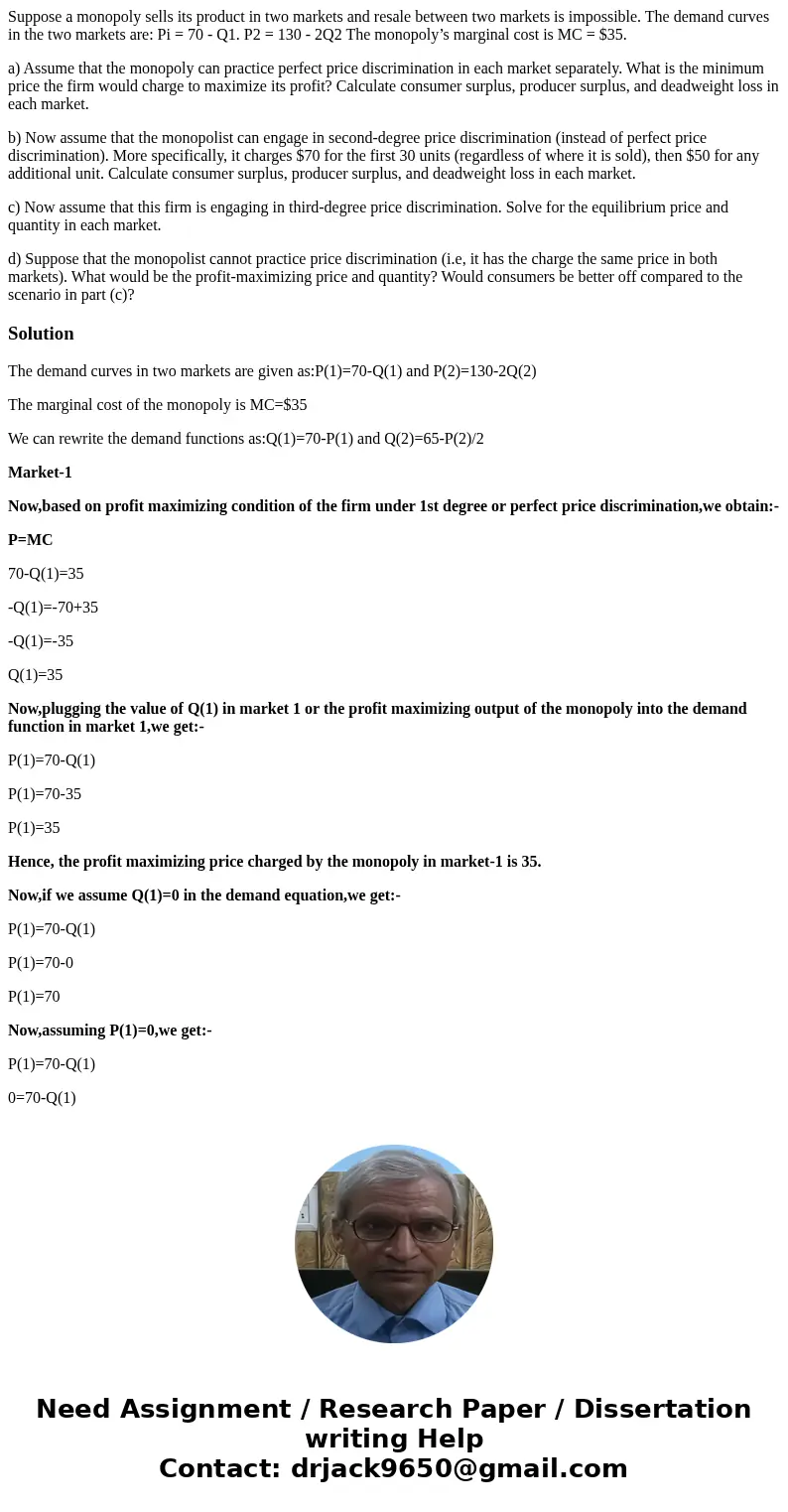
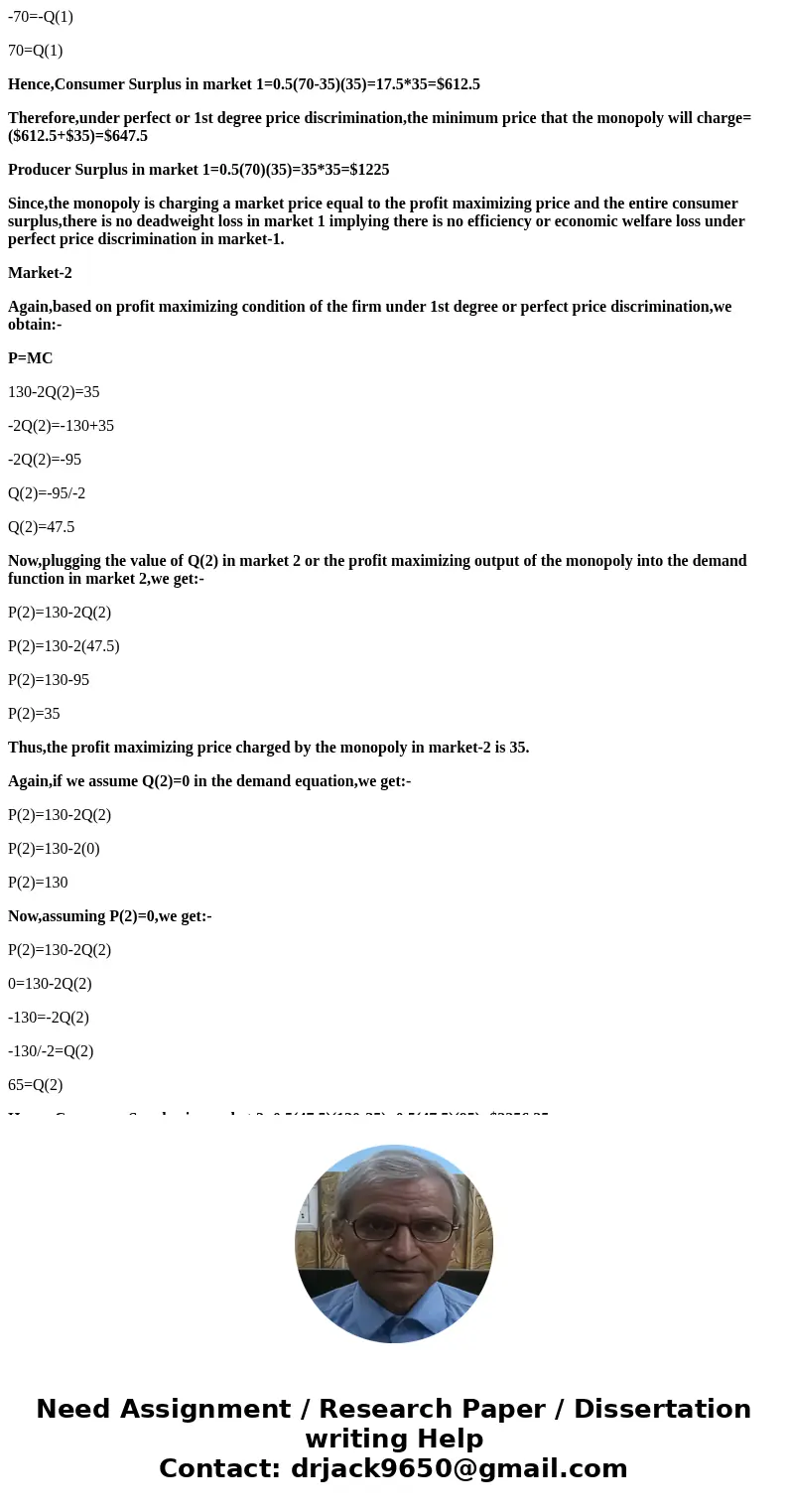
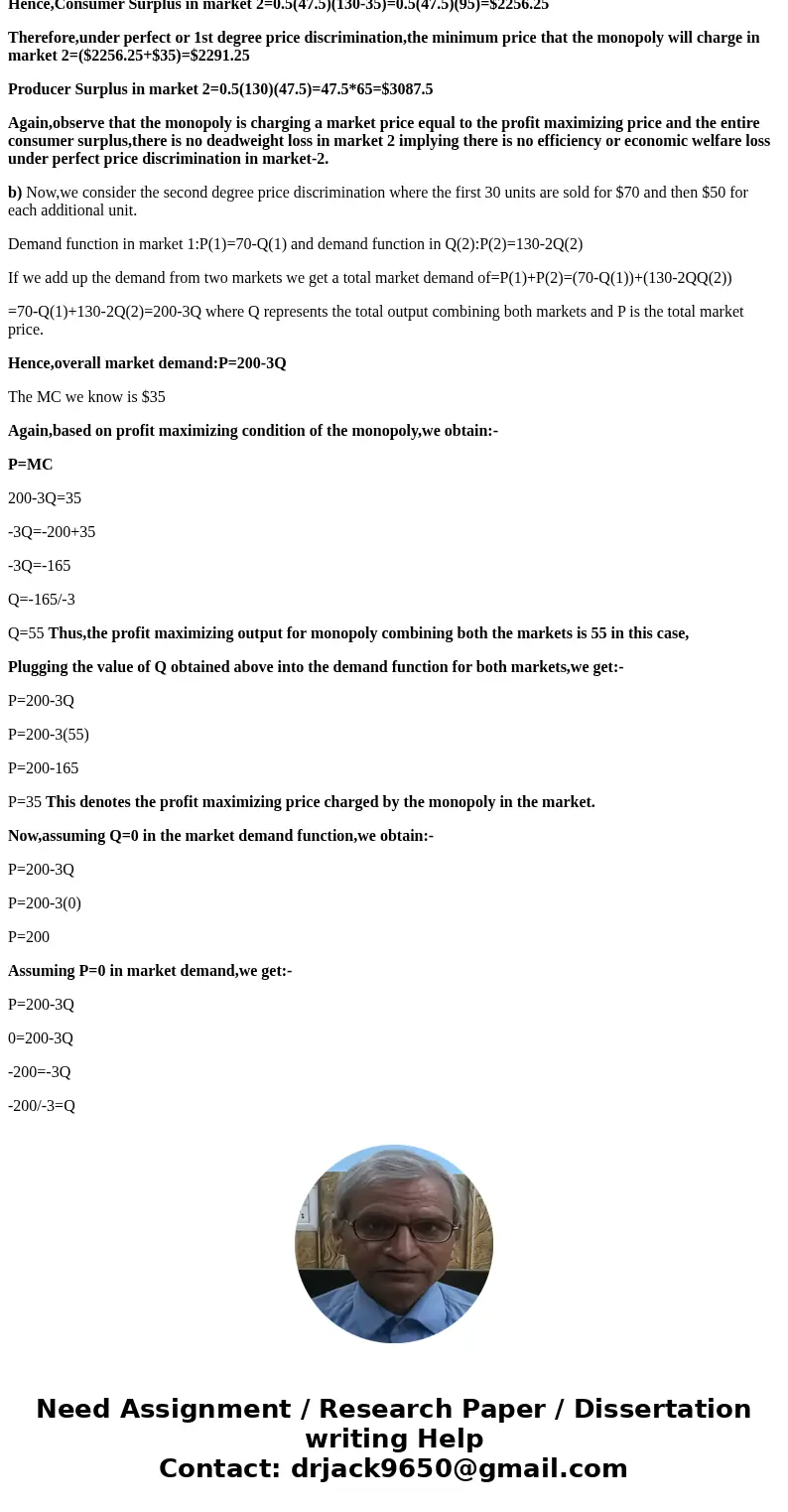
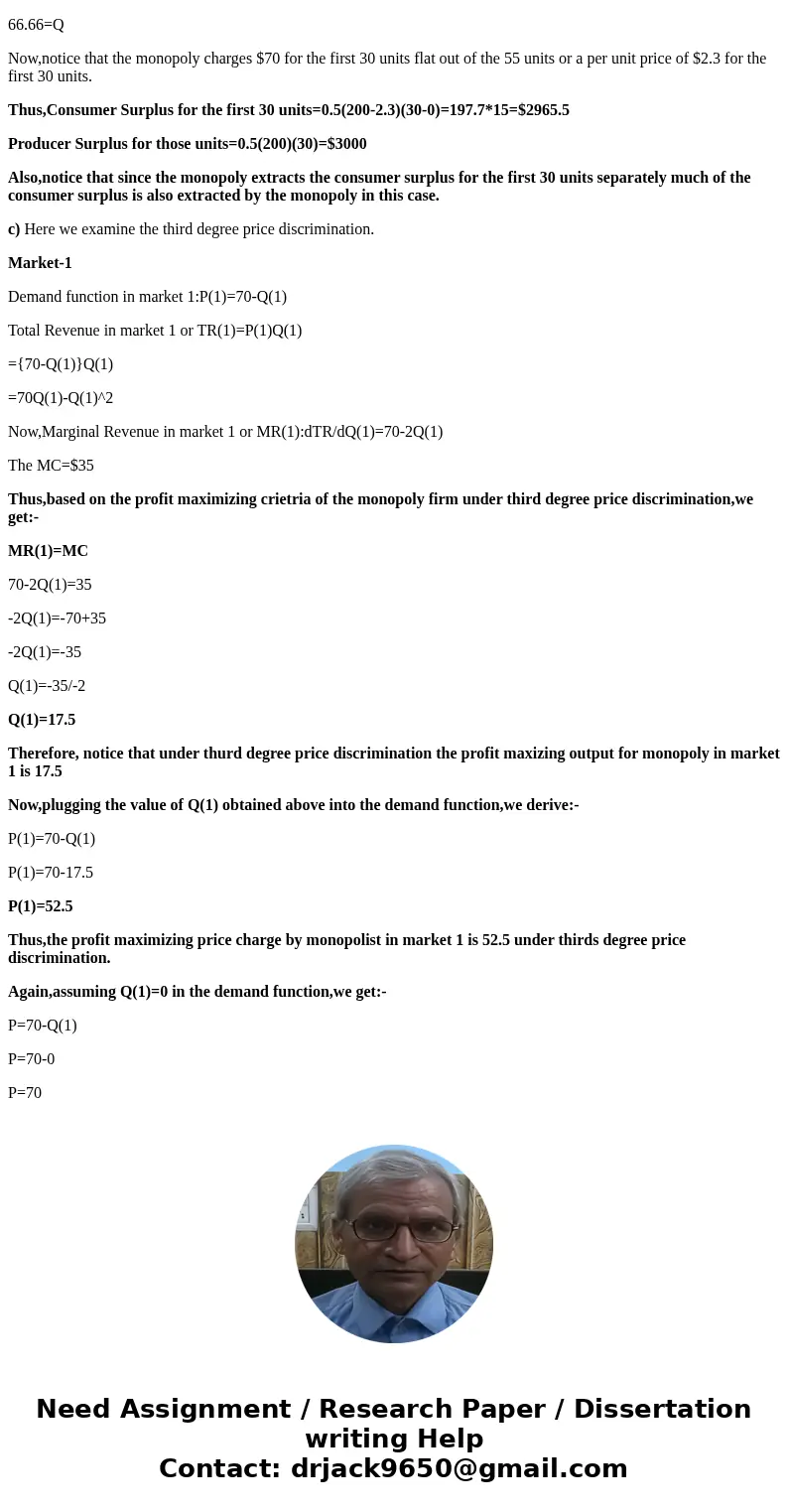
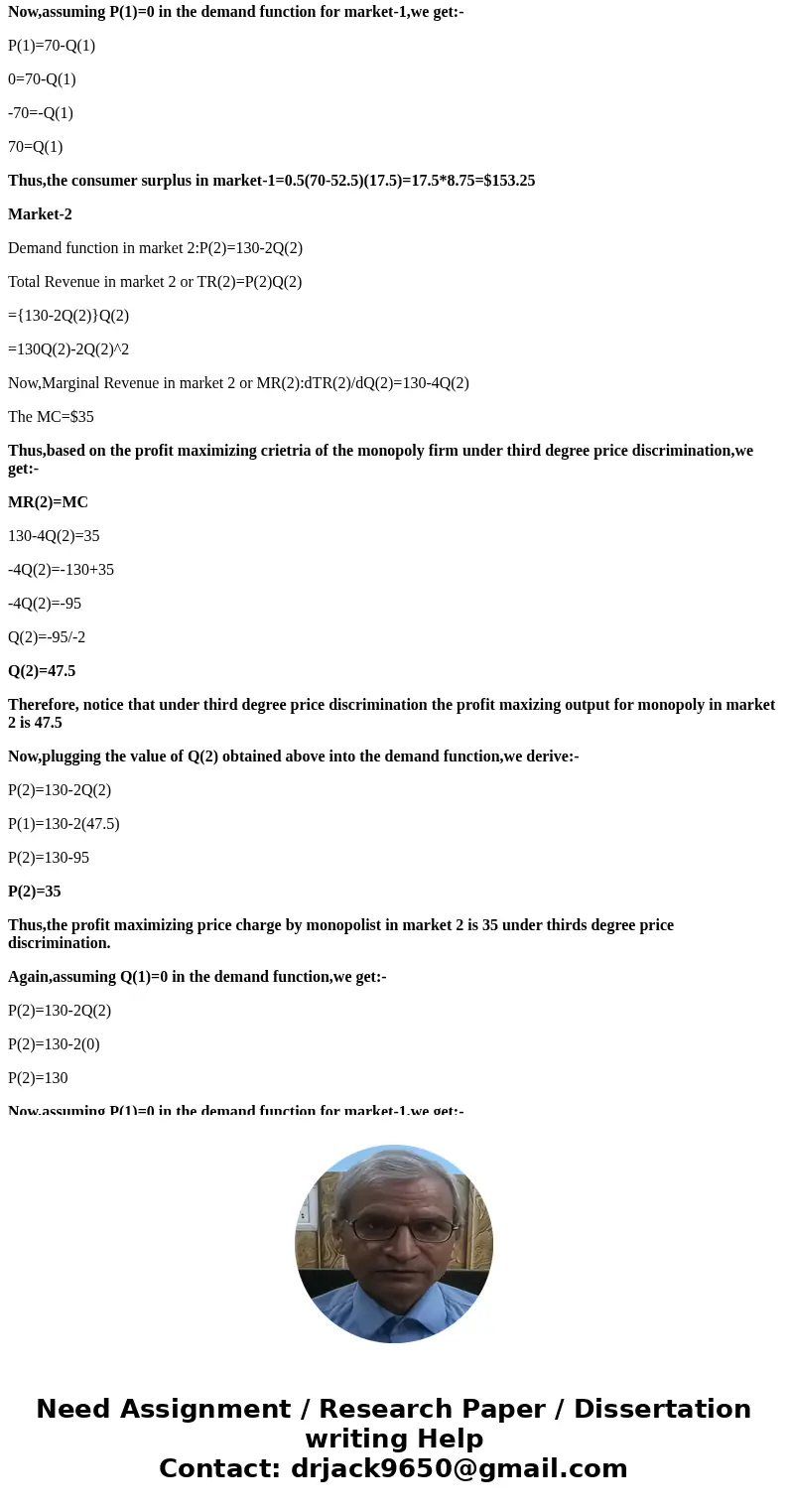
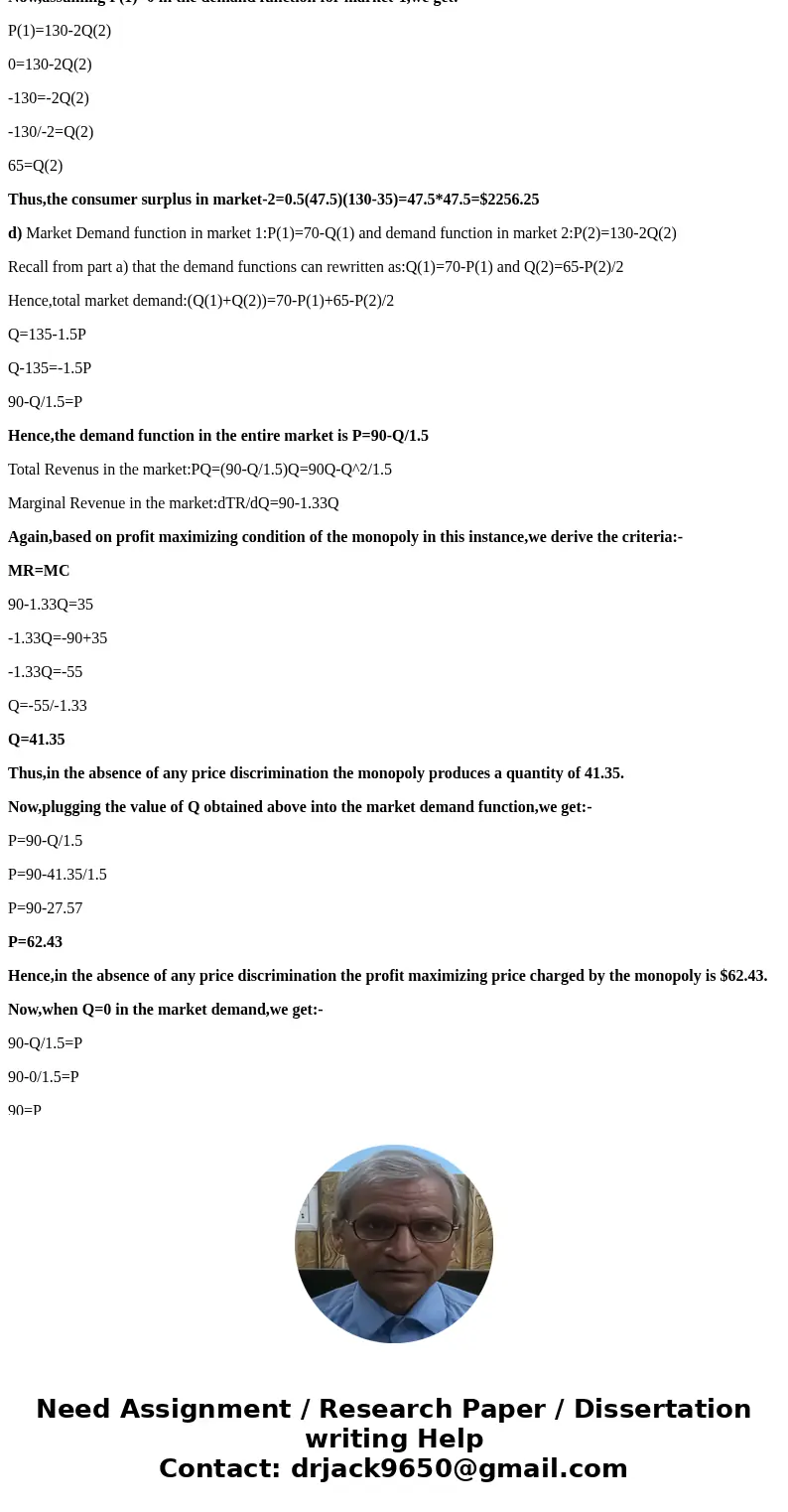
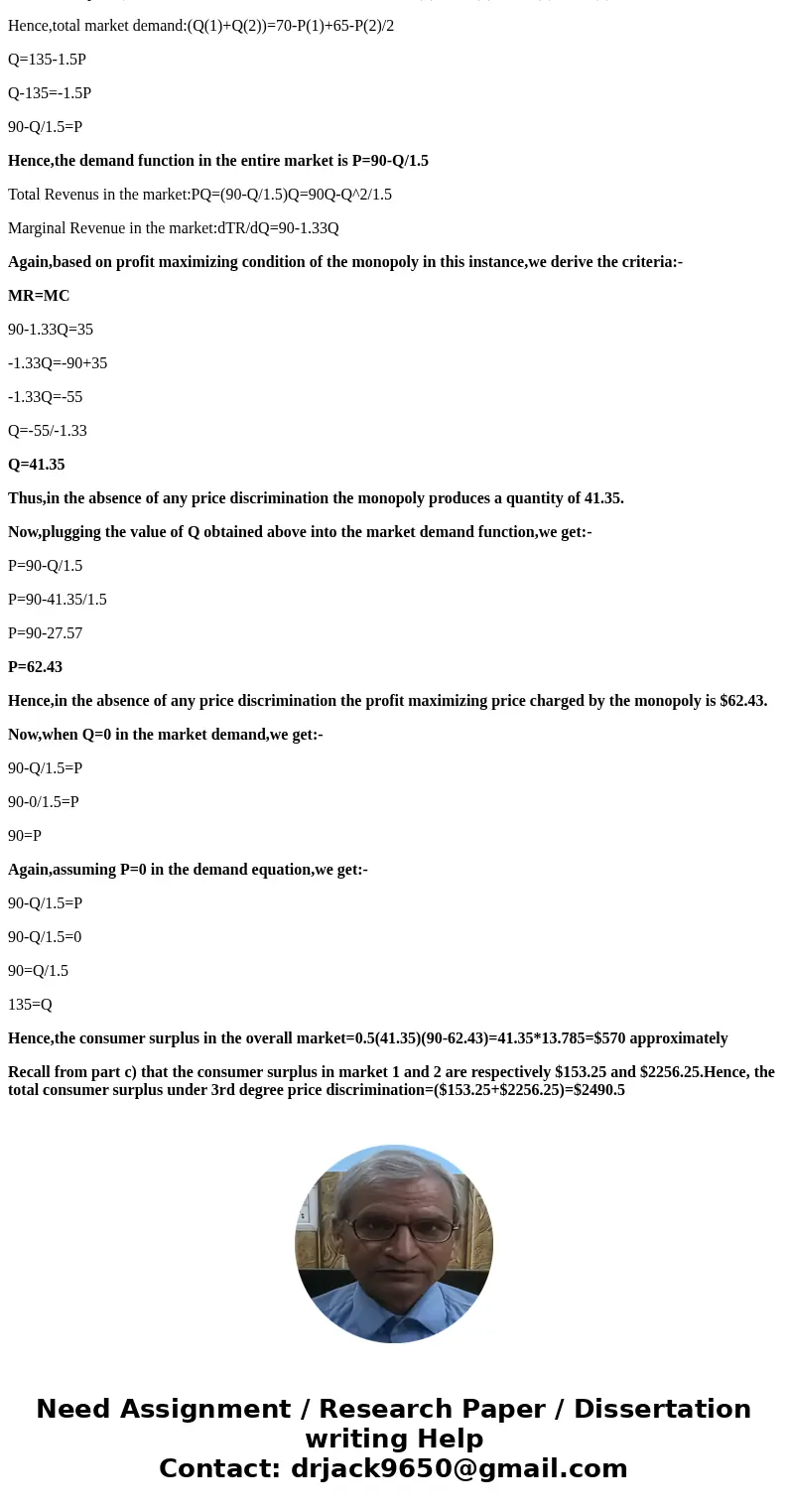
 Homework Sourse
Homework Sourse